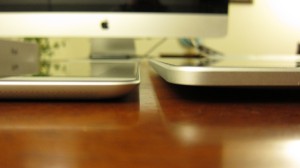After waiting in line at Best Buy yesterday to receive one of the 15 iPad 2s, I can honestly say Apple has not disappointed. After Steve Jobs unveiled the new iPad last week, many wondered what made this iPad different from the first generation model. The answer is all in the hardware.
HARDWARE
The iPad 2 had many new hardware features that make it far superior to the previous model. The most obvious is the body itself. The iPad 2 is only .34 inches thin and it feels completely different in the hand. The new flat back makes it feel like a thin book or, more appropriately, like a magazine. The aluminum back and glass screen make the iPad rigid and it feels incredibly durable.
 iPad 2 next to the original iPad
iPad 2 next to the original iPad
The addition of two cameras also sets the iPad 2 apart from its predecessor. The front-facing camera is VGA only and is meant for making Facetime video calls. The rear-facing camera is 720p HD video camera, but when taking pictures, the rear camera is less than 1 megapixel. The images are okay, but not the greatest quality. The iPad, however, is too large to be an effective camera. I have the iPhone 4, which has a 5-megapixel camera with flash. This serves the purpose when I am on the go. The cameras do well a video camera and that is their primary purpose.
The other major change to the iPad 2 is on the inside. Apple’s A5 chip is a 1 GHz dual core processor that has dramatically increased speed of day-to-day operation. The processor makes iPad 2 nearly twice as fast as the original and nine times faster with graphics. iBooks (Free) is noticeably quicker. Games that are heavy on the GPU are noticeably faster and more detailed. The other major change is the iPad 2 has 512 MB of RAM instead of the previous generations 256 MB. This allows the iPad to keep more open webpages in its memory as well as operate apps better in the background. Also added under the hood is a gyroscope that give better control when playing games.
Unchanged on the iPad 2 is the screen. The 9.7 inch display is unchanged, but still just as rich in detail. The bezel surrounding the screen remains the same size but now comes in black or white. Overall, the hardware of the new iPad 2 is what gives it its competitive edge.
SOFTWARE
The iPad 2 came preloaded with Apple’s new iOS 4.3 release. This came with such improvements as quicker Safari browser, Air Time updates, and the option to use the switch on the side of the iPad for mute or rotate lock functionalities.
 iMovie for iPad
iMovie for iPad
There are a few additions to iOS 4.3 that are only found on the iPad 2, however. The Facetime app is like the one on the iPod Touch and works very well. There is a camera app like on the iPod and iPhone, but the big story is Photo Booth. If you have a Mac, you know what Photo Booth is capable of. It takes funny pictures of you and your friends for you to post all over your Facebook wall, but Photo Booth does more than that. It shows off the incredible speed of the new A5 processor.

Drums on Garage Band
There are a few other apps Apple has created to take advantage of the iPad 2’s cameras and speed. The first is iMovie ($4.99). This is currently available for the iPhone and is a capable app. It allows you to edit movies you have made with your iPad. The other app is Garage Band ($4.99). On the Mac, Garage Band only works with physical instruments, but with the iPad the instruments are virtual. Whether you play the piano, guitar, or drums, Garage Band has you covered. They also have “Smart Instruments” for those of us who are not musically inclined. In addition to instruments, Garage Band allows the user to mix tracks and use the iPad as an amp for several instruments.
OVERALL
iPad 2 is a very solid device and one that I will use every day. Like the original iPad, the iPad 2 has a wide variety of accessories including Smart Covers ($39 – $69) which use magnets to attach to the iPad and easily lock and unlock the iPad by just closing or opening the cover. I purchased a grey Smart Cover and it works very well and does not add a lot of bulk to the design. What is truly amazing is that with the smaller size, new hardware, and added speed, the iPad 2 retains the original iPad’s 10-hour battery life and price point. I purchased the 32GB black Wi-Fi iPad 2. Of course, everyone wonders what Apple has in store for the next iPad, as well as this summer’s iOS 5 update, but for now, I have no problem waiting with the iPad 2.












